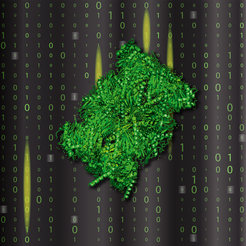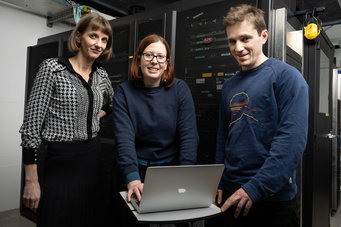Protein recycling for immune defense
The waste system of living cells, the proteasome, does more than just break down worn-out or damaged proteins. It also helps the immune system recognize cancer cells or cells infected by a virus by producing protein snippets called immunopeptides. In an international collaboration, researchers led by Juliane Liepe at the Max Planck Institute (MPI) for Multidisciplinary Natural Sciences have now recreated protein degradation by the proteasome in the laboratory and identified and quantified the peptides formed in the process. The data set generated could in the future help predict immune peptides and develop novel vaccines against infectious diseases or cancer.
Circular economy and recycling – a top topic these days. Living cells have already perfected something that often doesn’t go quite smoothly in our everyday lives: the proteasome, as a recycling system, breaks down proteins that are no longer needed or are damaged. The resulting peptides can then be used as building blocks for new proteins or brought to the cell surface, where they serve as “signal flags” for our immune system. Certain cells in our immune system check whether they are the body’s own or foreign. “Based on the unknown peptides, they recognize: Something is wrong here! “In this way, immune cells can distinguish between healthy and infected or cancerous cells,” explains Juliane Liepe, research group leader at the MPI for Multidisciplinary Natural Sciences. The immune system can then destroy the affected cells or cancer cells.
Recycling under the microscope
© Hanna Rötschke / Max Planck Institute for Multidisciplinary Natural Sciences Using innovative computer programs and biochemical experiments, researchers identified and quantified fragments that the cellular garbage disposal – the proteasome – creates and reassembles during protein recycling. © Hanna Rötschke / Max Planck Institute for Multidisciplinary Natural Sciences
But the proteasome doesn’t just break down proteins into smaller peptides. It can also put several of them back together. This process is called peptide splicing. A significant number of the peptides presented to the immune system are such spliced variants.
The research group Quantitative and systems biology um Liepe is particularly interested in the question of which spliced peptides contribute to immune defense and the rules according to which the proteasome produces them. “For example, if we know the spliced tumor peptides that cancer cells present to the immune system, they could potentially be used for immunotherapy in the future. To do this, we need to know which specific peptides the proteasome produces and what their significance is,” explains the bioinformatician.
In order to better understand the process of peptide splicing, the researchers used a laboratory experiment to simulate how the proteasome breaks down entire proteins and determined the peptides produced in the process qualitatively and quantitatively. For this extensive project, the research team cooperated closely with scientists from Francis Crick Institute and the King’s College London (Great Britain), the National University of Singapore as well as teams led by Stefan Becker, Ashwin Chari and Henning Urlaub at the MPI. Together they were able to generate the largest known data set of peptides produced from proteins by the proteasome under laboratory conditions.
In addition to biochemical experiments and mass spectrometry methods, the researchers also used computer-aided methods, some based on machine learning. “Among other things, we have developed new computer programs to identify and quantify unspliced and spliced peptides,” says Liepe.
Because of coincidence
© Swen Pförtner / Max Planck Institute for Multidisciplinary Natural Sciences Dr. Juliane Liepe (left) with the two first authors Hanna Rötschke and John Cormican. First author Wai Tuck Soh is missing from the picture. © Swen Pförtner / Max Planck Institute for Multidisciplinary Natural Sciences
Using their data, the scientists discovered some of the secrets of the proteasome. Neither the cutting nor joining of peptides occurs by chance. “We found that the proteasome preferentially processes certain protein areas,” explains Michele Mishto, head of the London research group. “This is due, among other things, to the proteasome’s preferences for certain sequences of protein building blocks,” reports Wai Tuck Soh. “We also discovered clear characteristics of how spliced and non-spliced peptides differ,” adds Hanna Rötschke, who, along with Soh and John Cormican, is the first author of the paper now published in the journal Nature Communications published work.
New approaches to vaccine research
“If we know how the proteasome produces immune peptides, we can predict peptide splicing. These predictions could in turn support the development of novel vaccines against cancer or infectious diseases in the future,” says Max Planck research group leader Liepe.


